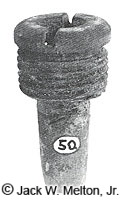Hotchkiss Time Fuze

Complete brass
Hotchkiss time fuze plug

Cross-section of the brass
Hotchkiss time fuze plug
Hotchkiss Time Fuze
|
|
|
|
| The Hotchkiss fuze plug is made of brass and has a screwdriver slot across the face. The plug is threaded and was screwed into the fuze well of the projectile. A paper time fuze, composed of a powder composition tightly wrapped in paper, was then driven into the center of the plug. The length of the fuze determined the amount of time it took to finish burning. The artillerist could either choose a manufactured fuze or alter the length of a fuze so that it would burn for a shorter period of time. Then the fuze burned through to the end, the flame was transmitted through the hole in the fuze plug and into the powder chamber of the projectile. This is a representative example of this class of time fuzes. | |